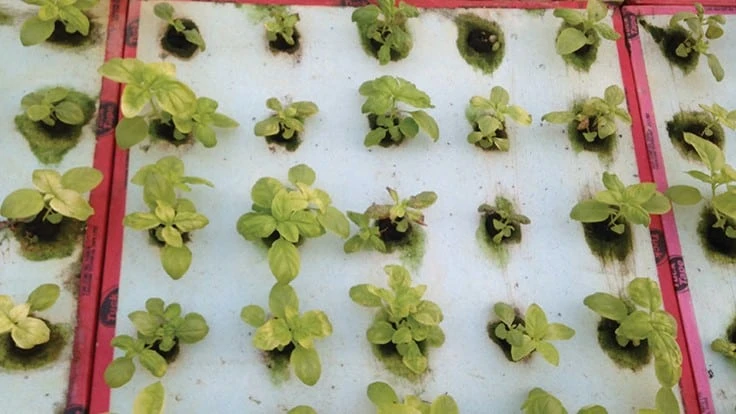


Editor’s note: This article originally ran as an e-GRO Edible Alert and is republished with the permission of the author.
Waterborne diseases that infect roots are a common production issue in hydroponic production. Several species of the water mold, Pythium, attack greenhouse crops. Basil and spinach are susceptible to economically devastating levels of Pythium root infection in hydroponics. In this article, we will present symptoms of Pythium infection and management strategies. Many Pythium species, are generalists, meaning they can attack a wide range of plant species. Pythium aphanidermatum and Pythium dissotocum are two species commonly reported in hydroponics. Both species can produce zoospores, a mobile propagule that can propel itself through water.

Symptoms of Pythium Root Rot
As Pythium infects and colonizes roots it can lead to a visible discoloration (browning) and decay of the root system (Figs. 1 & 2). Overall root system development may be poor with few lateral roots or root hairs (Fig.1). Often, the outer portion of the root (cortex) sloughs away leaving behind the inner part of the root (steele). This leads to the characteristic “rat tail” appearance of Pythium infected roots. The root system can eventually turn slimy and black. Shoots of affected plants may not initially show symptoms of Pythium infection, however, the plants may be reduced in overall size (Fig.3). As the disease progresses, plants may become severely stunted and leaves may be chlorotic (yellow) which is often mistaken for nutrient deficiency but is really caused by poor root system development (Figs. 4-6). Plants may also wilt due to inability of the root system to support plant water needs. At first, wilting may take place during only the hottest, brightest time of the day, but eventually wilting may become permanent.

Management
Once plants are infected, Pythium can be very difficult to control. Therefore, the best approach to Pythium management is adopting a suite of practices that reduce or eliminate exposure to the disease organism, restrict its spread and promoting environmental conditions that reduce disease proliferation.
Exclusion and Sanitation
There are several ways Pythium can enter greenhouse operations, including from: water (especially surface water sources), soil and plant residue


Environment
Environmental conditions that favor Pythium include excessively high fertility, waterlogged substrates (for example, in the seedling stage), low dissolved oxygen and extreme temperatures. Injury to roots such as through mechanical damage, allowing roots to dry out, or extreme temperatures can provide an entry point to Pythium. Maintain a target root zone temperature of 68 to 75° F (20 to 24° C). Lower temperatures favor establishment of Pythium dissotocum and higher temperatures favor development of Pythium aphanidermatum. At Cornell University, we have found that use of a water chiller to reduce hydroponic pond temperatures to about 68° F is an effective way to reduce, but not completely eliminate, Pythium aphanidermatum from ponds with baby leaf spinach. Low dissolved oxygen levels in hydroponics have also been reported to increase Pythium infection. Therefore, it is important to ensure adequate aeration so as to achieve greater than 6 ppm dissolved oxygen and ideally saturated dissolved oxygen (about 8-9 ppm O2) in nutrient hydroponic solutions.
Biofungicides
Biofungicides are microbial-based products that act to prevent disease development. Several commercially available products are labeled for control of root-disease of greenhouse vegetable crops. Some of these materials are primarily suited for use in substrates (such as seedlings or larger plants growing in container media) while some are also meant for use in hydroponic nutrient solutions. Biofungicides should be used as a preventative control strategy before a problem arises (rather than as a curative). Always follow the product label and be sure to check if a given material is registered for use in your state.
In summary, if you are growing hydroponic basil or spinach you will almost certainly come across Pythium. However, careful attention to your growing practices and sanitation procedures can limit this disease to an occasional annoyance rather than an annihilating nemesis.

Explore the March 2020 Issue
Check out more from this issue and find your next story to read.
Latest from Produce Grower
- The Growth Industry Episode 3: Across the Pond with Neville Stein
- PG CEA HERB Part 2: Analyzing basil nutrient disorders
- University of Evansville launches 'We Grow Aces!' to tackle food insecurity with anu, eko Solutions
- LettUs Grow, KG Systems partner on Advanced Aeroponics technology
- Find out what's in FMI's Power of Produce 2025 report
- The Growth Industry Episode 2: Emily Showalter on how Willoway Nurseries transformed its business
- 80 Acres Farms expands to Georgia, Texas and Colorado
- How BrightFarms quadrupled capacity in six months





